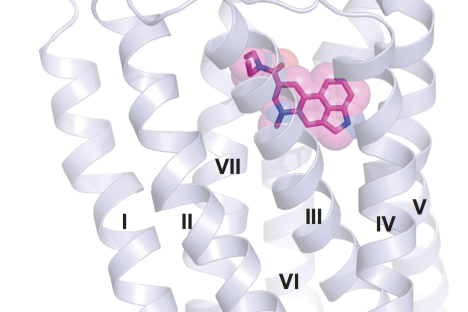Archived Content
The National Institute of Mental Health archives materials that are over 4 years old and no longer being updated. The content on this page is provided for historical reference purposes only and may not reflect current knowledge or information.
Revealed: LSD Docked in its Human Brain Target
Molecular structure may hold clues to design of new therapeutics
• Science Update
LSD ’s chemical diagram has long been a counterculture icon, but exactly how that structure works in the brain to achieve the drug’s potent mind-altering effects has remained a mystery. Now, an NIMH grantee has discovered the key pieces of the puzzle – unveiling the molecular structure of LSD interacting with its target protein in the human brain, a receptor for the chemical messenger serotonin. The findings are providing the first structure-informed insights into the molecular mechanisms of a hallucinogen.
Bryan Roth, M.D., Ph.D. of the University of North Carolina, and colleagues, report on the crystal structure of LSD bound to the serotonin 2B receptor on January 26, 2017 in the journal Cell.
In addition to the molecular secrets of hallucinations, the new findings may hold clues to the roots of psychopathology and consciousness – and lead to improved treatments, such as for anxiety associated with life-threatening conditions, say the researchers.
“This study sheds light on the mechanism of psychoactive drug action, including how certain drugs activate one signaling pathway inside cells while avoiding another,” explained Dr. Laurie Nadler, chief of NIMH’s Neuropharmacology Program, which is supporting the ongoing research. “Taken together with other recent studies of drug-receptor complexes, this work provides proof-of-concept for the design of drugs with desired signaling properties and fewer undesired side-effects.”
Roth and other colleagues recently demonstrated the potential of such structure-based design when they created a relatively side-effect-free designer painkiller molecule, based on similar discoveries of the molecular structure of an opioid receptor.
As in that study, the new study found that the drug’s unique properties turned out to hinge on its strong bias for acting through one of two key pathways inside brain cells. But just the opposite of the painkiller, LSD’s molecular structure interacts with its receptor in a way that biases it to act mostly through a beta-arrestin pathway instead of through a G-protein pathway. Vastly different properties of LSD chemical cousins that seemingly differ only slightly were traced to differences in the way they structurally interact with the receptor.
The high-tech snapshots, achieved through x-ray crystallography, showed that the receptor structure effectively closes a lid over the LSD molecule, preventing it from quickly escaping – likely explaining the drug’s long-lasting effects, despite its rapid clearance from the body. A mutant form of the complex with a weaker lid showed reduced beta-arrestin pathway activity, while leaving G-protein pathway activity unaffected. This could signal that interactions between the lid and the drug might be critical for its psychedelic effects, suggests an accompanying editorial.
Roth’s team is currently similarly unraveling molecular secrets of a sister serotonin receptor (2A) which is the brain target of several existing psychotherapeutic medications, said Nadler.

LSD (red) docked in its receptor (white ribbon). X-ray crystallography imaging revealed the arrangement of atoms in the molecules.
Source: Bryan Roth, M.D., Ph.D., University of North Carolina
References
Crystal Structure of an LSD-Bound Human Serotonin Receptor. Wacker D, Wang S, McCorvy JD, Betz RM, Venkatakrishnan AJ, Levit A, Lansu K, Schools ZL, Che T, Nichols DE, Shoichet BK, Dror RO, Roth BL. Cell. 2017 Jan 26;168(3):377-389.e12. doi: 10.1016/j.cell.2016.12.033. PMID: 28129538
Chen Q, Tesmer JJG. A Receptor on Acid. Cell, 168, 3, 26 January 2017, http://dx.doi.org/10.1016/j.cell.2017.01.012
Grants
MH61887, MH82441
